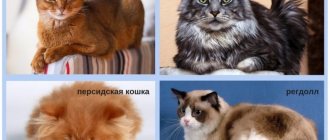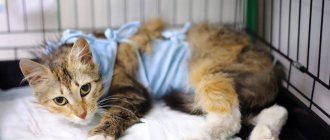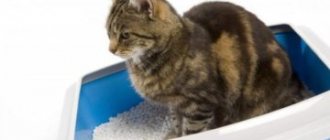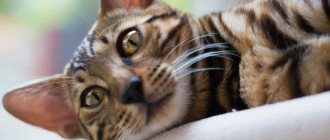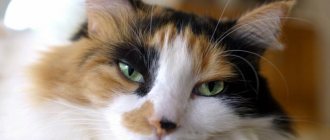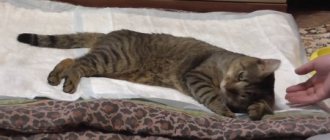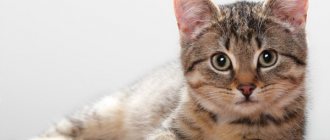Pets often suffer from problems with the digestive system. Often the owner himself is to blame for this, neglecting to properly feed the animal. Fecal retention is fraught with acute intoxication and possible damage to the intestinal walls. To prevent unpleasant consequences, a responsible owner needs to know what to do if his cat becomes constipated.
What can be considered constipation?
Constipation in a cat is a prolonged delay in defecation, making it difficult to completely or at least partially empty the intestines. To identify the problem, count how many times a day your pet visits the litter box. The norm for adult animals is 1 time per day, for older animals – 1 time every two days, for kittens – 2 times per day. The frequency of bowel movements depends on the metabolic rate. The younger the animal, the faster its metabolic processes.
Separately, it is worth considering the feces themselves. In a healthy cat, they should be oblong, soft and dark brown. A change in shape, consistency and color is a reason to contact a veterinary clinic.
Symptoms
The absence of feces in the tray is a reason to be wary.
A healthy cat defecates once a day, sometimes less or more often. At the same time, the feces are soft, homogeneous and without lumps. If a cat does not go to the litter box for more than 2 days, then the owner should pay attention to changes in behavior. As a rule, the pet climbs into the toilet and characteristically sits down, but nothing happens (or hard fecal balls with a diameter of 0.5–1 cm are expelled). This is a clear sign of a serious bowel problem.
With difficulty defecating, the cat looks lethargic and painful, does not play, sleeps a lot and rarely eats, the abdomen swells and becomes hard to the touch. In severe cases, the animal develops a fever or begins vomiting.
Often the animal stops licking itself, so it looks untidy. When the owner tries to feel the stomach, it reacts painfully.
Mastocytoma
Why does a cat snore and what to do?
The cat can't go to the toilet
An attentive owner will diagnose constipation based on suspicious behavior and visible symptoms.
The veterinarian is not limited to visual examination and palpation of the peritoneum. Additionally, an ultrasound, x-ray is prescribed, and blood and urine tests are taken to rule out other diseases.
Reasons for lack of stool
Lack of stool is only a symptom, not a disease. Before starting treatment, you need to understand what the root cause is. Defecation delay occurs when:
- foreign body entering the digestive tract;
- neoplasms or accumulation of hairballs in the intestines, that is, obstruction;
- stress associated with moving, separation from mother or the appearance of new family members;
- inflammation in the anal glands or rectum, accompanied by acute pain when trying to defecate;
- pancreatitis, that is, inflammation of the pancreas;
- poor nutrition – insufficient amount of water, fiber and animal proteins;
- infection with helminths;
- hormonal disorders;
- taking antibiotics, diuretics, anthelmintics and antihistamines;
- excess weight caused by a sedentary lifestyle;
- insufficient hygiene of the tray or unpleasant odor of the litter.
Possible causes also include surgery. If the cat has recently been spayed or neutered, then just wait until the effects of anesthesia wear off. Detailed instructions for care and actions in case of complications can be obtained from your veterinarian.
Preventing constipation in cats
To prevent constipation in your pet, you should follow these recommendations:
- cats, especially those with long, thick hair, should be brushed regularly (during the period of fur renewal, it is better to do the procedure daily);
- long-haired and very clean cats who carefully care for their coats must be given special pastes that dissolve and remove hair from the gastrointestinal tract;
- The cat should always have free access to clean water (the water should be changed frequently, since the animal will not drink stagnant liquid);
- the cat needs to be provided with a varied and proper diet, and not fed with inappropriate food;
- cats prone to laziness must be regularly involved in games and interesting activities to prevent physical inactivity;
- In order to prevent the cat from swallowing small objects, you should carry out regular cleaning and do not leave children's toys with small parts, handicrafts and other things that may interest the animal in the cat's access area.
Once a year, the cat must be taken to the veterinarian for a medical examination. This will help to promptly identify emerging diseases and, if necessary, begin treatment.
Symptoms of the problem
If your pet begins to visit the litter box less often than usual, watch him. For behavioral reasons associated with stale filler, it will regularly make piles in the wrong place. Don't scold your pet for this and change the tray more often. Clean animals rarely walk past their toilet. When an unpleasant odor appears, they can meow loudly, calling on the owner to solve the problem. Be attentive to such situations.
A serious pathology can be indicated when accompanying symptoms appear, including:
- painful and swollen abdomen;
- vomit;
- temperature increase;
- depression and refusal to eat;
- prolonged stay in the tray, accompanied by plaintive meowing;
- mucus or blood in the stool, changes in its color and consistency;
- the presence of blood on the anus or its swelling caused by trauma to the rectum.
The absence of bowel movements, followed by periodic diarrhea, is a sign of enterocolitis, that is, simultaneous inflammation in the small intestine and rectum. Only a doctor can make an accurate diagnosis. After detecting the listed symptoms, be sure to make an appointment with a veterinary clinic.
Proper nutrition and other preventive measures
Malfunctions of the intestines can be avoided with the help of preventive measures related to proper nutrition and animal care. For the health of your mustachioed pet:
Take care of the quality and balance of your diet. The lack of coarse fibers impairs peristalsis. Add vitamins and bran to your food, discussing acceptable options with your veterinarian. Specialized foods are suitable for cats with chronic diseases.
Take up gardening. Grow a small plantation of healthy herbs right on the windowsill or purchase a ready-made version in the store.
Stay physically active. Play cooperative games regularly and buy a few toys suitable for independent fun.
Brush the coat regularly. The longer the fur coat, the more often it will have to be combed. Also, the accumulation of hairballs in the stomach can be prevented with special dissolving pastes.
Change the bowl of water regularly. The animal should not suffer from dehydration.
Treat for helminths every quarter.
Don't forget to clean the litter box. Change the filler at least 3 times a day.
When purchasing a new family member, take care of comfortable living conditions in advance. Ask the breeder for your baby's personal belongings to reduce the stress of the move.
If you continue to have problems with bowel movements and accompanying symptoms appear, contact your veterinarian immediately. Attempts at self-medication can lead to the death of the animal. Never use dubious folk remedies without waiting for the approval of your doctor, and prevent dangerous actions on the part of your friends. Not all owners know about the dangers of castor oil, so share useful information with those around you.
The article is for informational purposes only. Contact your veterinarian!
Let fellow pet lovers know what you think.
The danger of going without bowel movements for a long time
With prolonged absence of stool, feces accumulate in the intestines. If the delay is partial, then the accumulation process lasts longer, but this does not reduce its danger.
Feces are toxic waste. The longer they remain in the body, the more they poison it. This affects the functioning of internal organs and can provoke the appearance of tumors. When a complete blockage occurs, intestinal obstruction occurs - a dangerous condition that can be fatal.
Under the pressure of feces, the intestinal walls can rupture. All contents will enter the body, causing severe intoxication. To avoid the death of your pet, you should urgently contact a veterinary clinic if the cat has not walked for more than 2-3 days in a row.
Feeding cats for constipation
The main symptom of constipation is the inability or difficulty of defecation. When defecating, the animal strains its back, meows pitifully, and signs of intoxication are also observed. However, it is necessary to put your pet on a special diet even in pre-morbid conditions. It can be determined by the consistency and shape of the stool.
Nutrition for constipation greatly depends on the cause and severity of the pathology. Normally, feces in cats look like soft pieces or “sausages” with a smooth surface and rounded edges. If you see that immediately after defecation the stool is dry, has cracks on its surface or has the shape of round dense nuts, then you need to put your pet on a diet.
All causes of constipation are divided into 2 types:
- Mechanical and anatomical. Constipation is caused by a tumor or foreign body. It also often occurs in pets who have a narrowing of the intestine due to scarring and other anatomical defects. The symptoms of this group are the rapid development of pathology and severe pain.
- Functional constipation. They arise due to intoxication, obesity, lack of water and various gastrointestinal diseases. The clinical picture of constipation in this group is often enriched with symptoms of various pathologies: pancreatitis, colitis, flatulence and others.
How to help an animal first
Eliminate feeding for a couple of days. This will reduce the load on the intestines. To soften stool, ensure adequate fluid intake. If your pet avoids water, drink it through a syringe without a needle.
A cat constipation laxative should only be prescribed by a veterinarian. Independent choice of medications is fraught with intensification of the inflammatory process. To alleviate the condition, before visiting the veterinary clinic, you can give your pet Vaseline oil, but only if there is no vomiting.
Unlike adult cats, constipation in kittens is often associated with separation from the mother too early. Try giving them a light massage, moving along the tummy towards the anus. Massage movements stimulate peristalsis and help with bowel movements.
If you are not sure of the reason, then it is better to entrust the kitten to specialists. He is more vulnerable to intoxication, and his intestines become clogged with waste faster. If presentation is late, the baby may need the help of a surgeon.
Dosage of the drug
The dosage of petroleum jelly should be calculated based on the method of administration, age and weight of the animal. Typically, the instructions accompanying the drug indicate the following numbers:
- For preventive purposes, 0.5 ml of oil per kg of weight should be administered.
- During the treatment period - 1 ml per kg of weight.
Within 3-4 hours after the manipulations, the cat will most likely successfully go to the toilet, but if this does not happen, then it will be necessary to re-introduce the oil (5-6 g), and after 1 hour repeat the procedure again (in the same dosage ).
In total, the number of procedures should not be more than five, and the maximum permissible daily dose for an adult cat is 20 ml. If there is no reaction of the animal’s body to the drug, it is necessary to urgently seek veterinary help.
Important! It is necessary to follow the rules for using the oil, otherwise the drug will either not cope with the problem or will cause additional disruptions to the gastrointestinal tract. In case of prolonged constipation, your cat can be given an enema.
To carry it out, you will need an assistant who will hold the pet during the administration of the drug.
In case of prolonged constipation, the cat can be given an enema. To carry it out, you will need an assistant who will hold the pet during the administration of the drug.
- You need to purchase a syringe from a veterinary pharmacy. Add up to 10 ml (if the animal is light in weight, you should add about 5 ml) of oil. The drug can be used either in its pure form or half diluted with water and heated to a temperature of 36°C.
- Lubricate the tip of the enema (lubricant is perfect for this) and smoothly move it into the lumen of the rectum 1.5 cm.
- If the animal’s body does not react during the first 10 minutes after the procedure, it is necessary to repeat the manipulation again after 3 hours at the same dosage.
- If the second microenema also does not help, then you need to seek veterinary help. Most likely, the animal's intestines are already clogged with fecal stones and surgery will probably be required to remove them.
Treatment options
Knowing the possible ways to treat constipation in a cat, you can easily avoid dangerous consequences. In the absence of accompanying symptoms and a single problem with bowel movements, you can cope with the situation on your own.
Drug therapy
It is recommended to consult a veterinarian before taking medications. By describing the animal's condition, you can find out what can be given to a cat for constipation and what cannot be given. Depending on the situation, your doctor may recommend the following types of laxatives:
- Volume-forming agents (Metamucil)
. They attract additional moisture from cells, increasing the volume of feces. Not suitable in an emergency situation.
- Emollients (Docusate sodium)
. Suitable for emergency emptying. Contraindicated when feeding or expecting offspring.
- Osmotic (Duphalac, Lactusan)
. Softens stool and stimulates peristalsis. Not suitable for urgent care, but have a beneficial effect on microflora.
- Lubricants (pastes for hair removal)
. They ensure free sliding along the intestinal walls by moisturizing them.
- Stimulants (Bisacodyl)
. They stimulate the contraction of intestinal muscles and help get rid of obstruction in a short time. Contraindicated for pregnant and lactating pets.
Self-administration of laxatives can lead to severe dehydration, so do not experiment on your pet. Sometimes it’s enough just to change the filler or change the diet. And leave anything more complicated to the doctor.
Castor or Vaseline oil
The most popular folk remedies are castor oil and Vaseline. Vaseline oil does not accumulate in the body, so it is difficult to overdo it with the dosage. Veterinarians recommend giving 1 ml per 1 kg of animal weight using a syringe or syringe. Once in the body, the oil softens stagnant feces and promotes their removal.
But it’s better to be careful with castor oil. The cat's body is not compatible with it, so instead of relief, you will cause your pet severe stomach pain.
Is it possible to give an enema?
Treatment of constipation in cats and kittens at home with an enema is permissible only after examination by a doctor. This procedure is prohibited for chronic pathologies and obstruction, as it can aggravate their course.
Working with an enema is complicated by unpleasant sensations. In the absence of skills, the pet will constantly break out, and a successful outflow of feces can “decorate” a considerable part of the room. If the veterinarian gives the go-ahead and you are not afraid of difficulties, read the detailed instructions and proceed with the procedure.
Why you shouldn’t use folk remedies
The main danger of folk remedies is the unpredictability of the body's reaction. The cat may develop allergies or severe poisoning. Healing decoctions are good in complex therapy, but only under the guidance of a doctor who has checked the absence of an allergic reaction to the main components. It will not be possible to eliminate the problem without more effective drugs.
Nutrition correction
At the initial stage of the disease (partial emptying of small balls), you can try to improve nutrition. Start feeding your pet:
- fractionally, increasing feedings to 6 times a day;
- more liquid food, soaking dry granules or adding broth to prepared dishes;
- lean ground meat and raw liver;
- ground pumpkin, carrots and beets, or simply feed the cat their juice through a syringe;
- milk porridges and fresh fermented milk products (yogurt, kefir).
Avoid foods that increase gas formation (legumes, yeast products), bones and cartilage. Temporarily eliminate rice, which has a strengthening effect, from your diet. Add a small amount of bran and vegetable oil to the dish (0.5 tsp per day), which stimulate peristalsis.
When using dry food, pay attention to the veterinary ruler marked i/d. These products are rich in coarse dietary fiber, as they are designed for those who suffer from digestive problems.
Massage
Not all pets are ready to let a person near their belly. If the animal trusts you, then try to accustom it to a light massage. Stroke your pet's belly clockwise at any free time. The procedure can be carried out with bare hands or a cloth dipped in cool water.
Why doesn't my little kitten poop?
The cat has hot ears: what does this mean?
Month-old kittens go to the toilet quite often (up to six times a day). Kittens are very small and the process of their bowel movements depends entirely on the mother cat. She teaches them this, and monitors their nutrition and stool. If the cat does not take good care of the baby, the kitten will not be able to go to the toilet.
Kittens go to the toilet
In addition, sometimes problems with bowel movements in kittens can be associated with a rare congenital pathology.
The process of defecation is also affected by a sharp change in diet, place of residence, and lack of mother's milk. When moving, you should panic only if the kitten does not go to the toilet for more than five days.
When do you need veterinary help?
You cannot do it on your own if any alarming symptoms appear that affect your pet’s usual state. A plaintive meow is a signal for help. Listen to your mustachioed pet and try to put off all other things until you find out the cause of the problem.
After abdominal surgery, carefully monitor the timing. Delayed bowel movements in the first days are explained by refusal to feed and weak peristalsis inhibited by anesthesia. If the condition does not return to normal within 2 days, contact your doctor. The cause of the delay may be damage to the walls of the rectum. In this case, repeat surgery will be required.
Oil laxatives and malt pastes
To relieve constipation in a kitten or pregnant cat, you can use Vaseline oil. It has a gentle effect on the large intestine, preventing the absorption of water. As a result, wet feces move towards the exit without difficulty and do not cause pain to the animal.
If it is difficult to determine which laxative to give your cat, you should feed it with an oil composition. For an adult animal, 4 tbsp is enough, for a kitten – 1 tbsp.
All cats love to groom themselves, so from time to time they regurgitate the fur that has accumulated in the digestive tract. But if the lump is too dense, constipation may form.
For such a problem, it is best to use lubricating-type preparations. Malt pastes help dissolve villi and remove them from the body in a natural way. The cat laxative is mixed with food or given to the animal directly from the tube.
The most commonly used malt pastes are BeapharMaltPaste and GimCatMalt-SoftPasteExtra. For an adult animal, 3–5 cm of the composition once a day is enough.
Prevention
To prevent constipation in cats from tormenting your pet throughout life, you need to follow preventive measures, which, as a rule, include the following:
- Long-haired cats need to have their fur brushed from time to time. Otherwise, the fur gets stuck in a lump and ends up in the pet’s intestines.
- To avoid treating your kitten for constipation in the future, you can buy phytomines at a pet store - these are products that help expel fur from your pet’s body. Phytomines contain lecithin and herbal extracts that help treat inflammation of the gastrointestinal tract.
- An excellent laxative is pumpkin. A tablespoon of boiled pumpkin added to your cat's food will help cope with stool retention.
- If the cat eats dry food, then it is necessary to provide free access to clean water.
- Regular medical examinations with a veterinarian will help avoid health problems for your kitten.
- Physical activity of the animal helps in preventing constipation. If your pet never goes outside, then he needs to take several toys to ensure physical activity.
Such an unpleasant problem as constipation in kittens can be easily dealt with if the owner watches the cat and pays him due attention. Having the necessary knowledge, you can protect your pet from all sorts of troubles, and the mustache will respond to its owner with love and attention
We recommend reading: How to properly give a cat an enema at home?
Why is castor oil persona non grata?
Frankly speaking, you can not pay much attention to all of the above... The problem is that modern veterinary medicine (and medicine, by the way) condemns the use of castor oil! Many experts are confident that its use should be completely banned, producing castor oil only for technical needs.
Why was such a popular drug in the recent past subjected to such a sharp “disqualification”? all about its side effects and the extremely specific action of ricinic acid , which at the slightest overdose can cause severe poisoning.
To be fair, we note that with a precisely adjusted dose, nothing like this is observed. But... even with three or four times of use, addiction quickly develops, which is why the dose has to be increased. And an increased dose = poisoning, and serious one at that.
In addition, many animals, even with proper use, develop violent diarrhea and uncontrollable vomiting .
Moreover, giving castor oil to a cat repeatedly (that is, two or more times) during the day is generally prohibited, since many pets develop severe digestive disorders!
Can castor oil be used to treat constipation in a cat?
Castor oil is one of the products that is not recommended for use without a veterinarian's prescription. The action of castor oil is too aggressive and can lead to the development of severe diarrhea. Despite the many positive qualities of this substance, its use in veterinary medicine is very limited.
The reason for “abstinence” is obvious - the positive qualities that are expected when treating people “backfire” when treating animals. For unknown reasons, castor oil is considered a good bowel stimulant that acts like an enema. Perhaps, when it comes to people, this information is partially true. When treating animals, this approach is considered very rude and unjustified.
Important! Most animals experience an acute reaction after using castor oil, resulting in cramping and severe diarrhea. If you decide to give your cat castor oil, be prepared for a range of side effects.
The first and most dangerous side effect is severe diarrhea, which can lead to dehydration in a matter of hours. Unlike Vaseline or linseed oil, castor oil has a pungent odor and taste. Forcibly pouring oil into a cat's mouth can lead to severe nausea and profuse vomiting.
If you decide to give your cat castor oil, be prepared for a wide range of side effects. The first and most dangerous side effect is severe diarrhea, which can lead to dehydration in a matter of hours. Unlike Vaseline or linseed oil, castor oil has a pungent odor and taste. Forcibly pouring oil into a cat's mouth can lead to severe nausea and profuse vomiting.
Important! Castor oil should absolutely not be used for intestinal blockage or volvulus. A mistake in this case will most likely cost your pet's life! Against the background of a sharp increase in peristaltic activity, after using castor oil, the cat may experience spasmodic pain and colic
To stop this condition, it is necessary to use drug treatment (antispasmodics), which is preferably administered by injection
Against the background of a sharp increase in peristaltic activity, after using castor oil, the cat may experience spasmodic pain and colic. To stop this condition, it is necessary to use drug treatment (antispasmodics), which is preferably administered by injection.
Conclusion. If you think your cat is constipated, it is better to consult with your veterinarian about methods and treatments that will really help your pet and will not harm his health.
